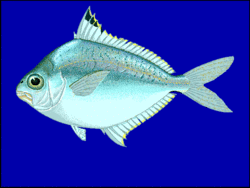Leiognathidae
| Leiognathidae Temporal range: 56–0 Ma | |
|---|---|
 | |
| Eubleekeria splendens | |
| Scientific classification | |
| Kingdom: | Animalia |
| Phylum: | Chordata |
| Class: | Actinopterygii |
| Order: | Perciformes |
| Family: | Leiognathidae T. N. Gill, 1893 |
| Genera[2] | |
Leiognathidae, the ponyfishes, slipmouths or slimys / slimies, are a small family of fishes in the order Perciformes.[2] They inhabit marine and brackish waters in the Indian and West Pacific Oceans. They can be used in the preparation of bagoong.
Ponyfishes are small and laterally compressed in shape, with a bland, silvery colouration. They are distinguished by highly extensible mouths, and the presence of a mechanism for locking the spines in the dorsal and anal fins. They also possess a highly integrated light organ in their throats that houses symbiotic bioluminescent bacteria that project light through the animal's underside.[4][5][6] Typically, the harbored bacterium is only Photobacterium leiognathi, but in the two ponyfish species Photopectoralis panayensis and Photopectoralis bindus, Photobacterium mandapamensis is also present.[7] Two of the most widely studied uses for luminescence in ponyfish are camouflage by ventral counterillumination[8][9] and species-specific sexual dimorphism.[5][6][10][11]
Although ponyfish seem quite ordinary and morphologically similar, their light organ systems are highly variable across species and often between sexes.[10][11]
Timeline of genera

References
- ↑ Sepkoski, J. (2002). "A compendium of fossil marine animal genera". Bulletins of American Paleontology. 364: 560.
- 1 2 Froese, Rainer, and Daniel Pauly, eds. (2015). "Leiognathidae" in FishBase. February 2015 version.
- ↑ Sparks, J.S.; Chakrabarty, P. (2015). "Description of a new genus of ponyfishes (Teleostei: Leiognathidae), with a review of the current generic-level composition of the family". Zootaxa. 3947 (2): 181–190. doi:10.11646/zootaxa.3947.2.2.
- ↑ Johnson, G.D. & Gill, A.C. (1998). Paxton, J.R. & Eschmeyer, W.N., eds. Encyclopedia of Fishes. San Diego: Academic Press. p. 186. ISBN 0-12-547665-5.
- 1 2 Haneda, Y.; Tsuji, F.I. (1976). "Luminescent systems of pony fishes". Journal of Morphology. 150: 539–552.
- 1 2 McFall-Ngai, M.J.; Dunlap, P.V. (1984). "External and internal sexual dimorphism in leiognathid fishes: Morphological evidence for sex-specific bioluminescent signaling". Journal of Morphology. 182 (1): 71–83. doi:10.1002/jmor.1051820105. ISSN 1097-4687.
- ↑ Kaeding, A.J.; Ast, J.C.; Pearce, M.M.; Urbanczyk, H.; Kimura, S.; Endo, H.; Nakamura, M.; Dunlap, P.V. (2007). "Phylogenetic Diversity and Cosymbiosis in the Bioluminescent Symbioses of "Photobacterium mandapamensis"". Applied and Environmental Microbiology. 73 (10): 3173–3182. doi:10.1128/AEM.02212-06. ISSN 0099-2240. PMC 1907103
 . PMID 17369329.
. PMID 17369329. - ↑ Hastings, J.W. (1971). "Light to Hide by: Ventral Luminescence to Camouflage the Silhouette". Science. 173 (4001): 1016–1017. doi:10.1126/science.173.4001.1016. ISSN 0036-8075. PMID 17796582.
- ↑ McFall-Ngai, M.J.; Morin, J.G. (1991). "Camouflage by Disruptive Illumination in Leiognathids, a Family of Shallow-Water, Bioluminescent Fishes". Journal of Experimental Biology. 156 (1): 119–137. ISSN 0022-0949.
- 1 2 Sparks, J.S.; Dunlap, P.V.; Smith, W.L. (2005). "Evolution and diversification of a sexually dimorphic luminescent system in ponyfishes (Teleostei: Leiognathidae), including diagnoses for two new genera". Cladistics. 21 (4): 305–327. doi:10.1111/j.1096-0031.2005.00067.x. ISSN 1096-0031.
- 1 2 Chakrabarty, P.; Davis, M.P.; Smith, W.L.; Berquist, R.; Gledhill, K.M.; Frank, L.R.; Sparks, J.S. (2011). "Evolution of the light organ system in ponyfishes (Teleostei: Leiognathidae)". Journal of Morphology. 272 (6): 704–721. doi:10.1002/jmor.10941. ISSN 1097-4687.